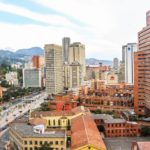Posts tagged with 'Building Efficiency Accelerator'
For Pittsburgh, it’s a focus on improving air quality and creating renewable energy jobs. For Paris, it’s encouraging social mobility and reclaiming pedestrian areas. The common thread in these cities’ climate action plans is a commitment to pledges made by ...

China has grand plans to green its buildings. The country’s national climate commitment calls for 50 percent of all new buildings constructed by 2020 to be certified green buildings, while its 13th Five-Year Plan prioritizes building efficiency. Following through on ...

The government of Da Nang, Vietnam has prioritized building efficiency as part of its new Resilience Strategy to address public health and economic risks from climate change. In 2016, the city began working with the global Building Efficiency Accelerator (BEA) ...

As Colombia’s capital and largest city, Bogotá has significant local government capacity. However, because of limited experience with implementing efficiency policies, the city lacks technical expertise to implement a new national building energy regulation or otherwise encourage more efficient construction. ...

One-third of the world’s energy-related emissions come from buildings. So perhaps it’s no surprise that more than 80 national climate plans submitted ahead of COP21 in Paris included commitments to improve building efficiency. A year later, the discussion continues with Human Settlements Day today at COP22 in ...

Urbanization presents major challenges: congestion, sprawl, inefficiency, health hazards and high cost of living, just to name a few. But the choices we make for our cities can transform these challenges into opportunities: mobility, connectivity, economies of scale, healthier lifestyles ...

Are you involved with decision making, operations or investments in the buildings and real estate sector? If the answer is yes, WRI Ross Center for Sustainable Cities invites you to please share your insights in a survey designed to expand ...

For some building owners, renovations—including retrofitting heating, cooling, and lighting systems—can be a way to attract tenants. For homeowners, improving insulation can make for more comfortable as well as energy efficient homes. For industry, more efficient equipment means expanding production ...

TheCityFix is covering cities at COP21. Urban areas account for a large share of greenhouse gas emissions but are also tremendous agents of innovation to address climate change. Read our full coverage of the Paris Climate Conference as it relates to cities, buildings, and mobility. This year ...

TheCityFix is covering cities at COP21. Urban areas account for a large share of greenhouse gas emissions but are also tremendous agents of innovation to address climate change. Read our full coverage of the Paris Climate Conference as it relates to cities, buildings, and mobility. Energy use ...

TheCityFix is covering cities at COP21. Urban areas account for a large share of greenhouse gas emissions but are also tremendous agents of innovation to address climate change. Read our full coverage of the Paris Climate Conference as it relates to cities, buildings, and mobility. In anticipation ...

When it comes to improving energy efficiency in buildings, cities can lead by example to create a big impact. By retrofitting public buildings, cities can demonstrate the benefits of action on energy efficiency and inspire change from within the private ...

Energy efficiency improvements in the building sector can yield significant financial and environmental benefits including reduced energy costs, decreased greenhouse gas emissions, improved occupant health and increased local employment. However, long standing market and policy barriers stand in the way ...

Investing in resource efficiency helps cities and their residents by cutting energy and water costs, creating jobs and creating cleaner, healthier air. And making cities more resource efficient is critical to reducing greenhouse gas emissions and combating climate change. Improving ...

Buildings are an important part of the sustainability picture for Mexico City. At least 20 percent of the city’s total greenhouse gas emissions come from buildings, with growth in coming decades expected to increase energy demand. This means that improving ...


































